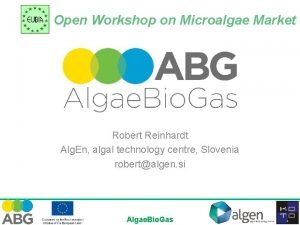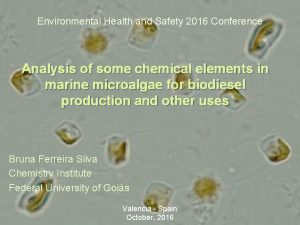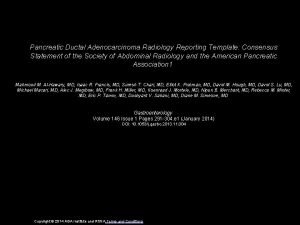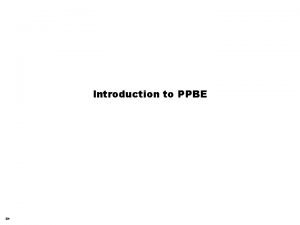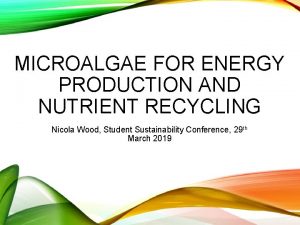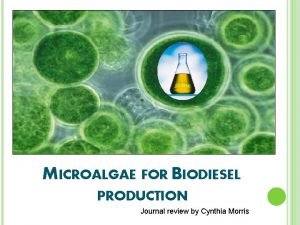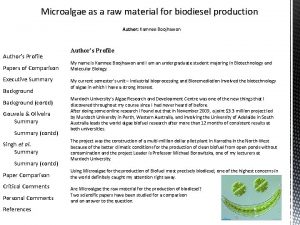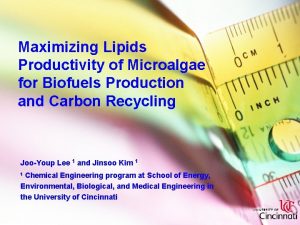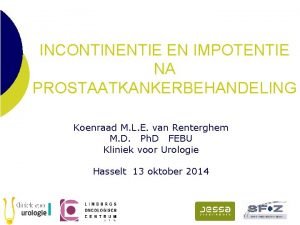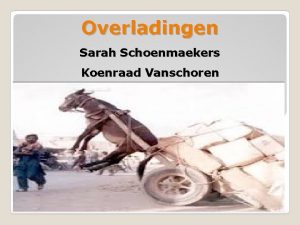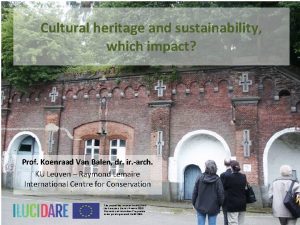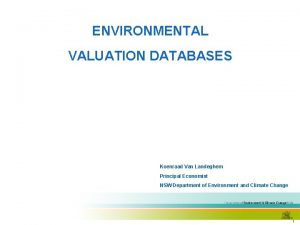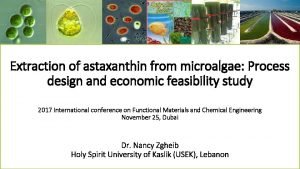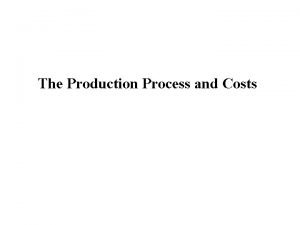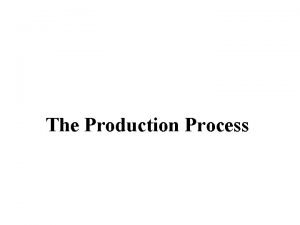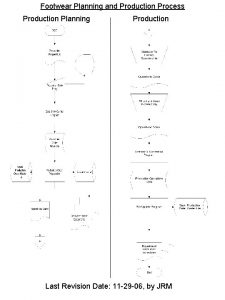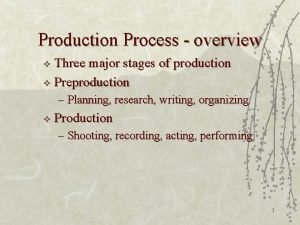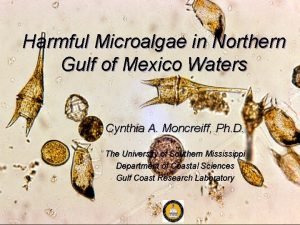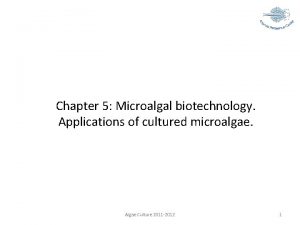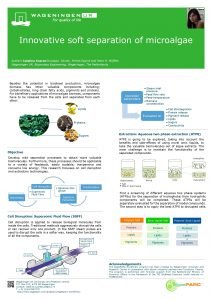Overview of the microalgae production process Koenraad Muylaert




























- Slides: 28

Overview of the microalgae production process Koenraad Muylaert


Historical use of microalgae (Spirulina, Tsjaad)

Photosynthesis Conversion efficiency for solar to chemical energy: • Maximum efficiency of photosynthesis: 12% • Belgium: 180 ton/ha/year • Short-term realised efficiency in experimental systems: 4% • Belgium: 60 ton/ha/year • Long-term realised efficiency in commercial systems: 2% • Belgium: 30 ton/ha/year

Productivity of microalgae Soy 11 ton Potato 17 ton Wheat 18 ton Corn Sugar beet Microalgae (practice) 25 ton 29 ton 35 ton 90 ton Microalgae (lab) Best practice annual production in ton dry biomass (leaves, stems, fruits) per hectare per year


Production of Arthrospira in open ponds in Hawaii

Production of Chlorella in a ‘photobioreactor’ in Germany

Cultivation of microalgae Open systems (raceway ponds) Closed systems (photobioreactors) Relatively cheap Expensive Sensitive to contamination Resistant to contamination Inefficient light use (respiration) Efficient light use Low biomass concentration High biomass concentration Experience in commercial systems Little experience on large scale

Biomass composition of microalgae fibre lipids sugars protein soybean microalgae

Biomass composition NO 3 -, NH 4+ proteins sugars CO 2 lipids

N supply and biomass composition Growth under sufficient N supply Amino acid synthesis NO 3 - light é NH 4+ PROTEINS NADPH ATP Calvin glucose CO 2 H 2 O O 2 Photosynthetic light reactions glutamine Photosynthetic dark reactions

N supply and biomass composition Growth under N limitation light é NADPH ATP Calvin glucose CO 2 H 2 O O 2 Photosynthetic light reactions Photosynthetic dark reactions starch/glycogen

Biomass composition high N, low CO 2 proteins sugars lipids low N, high CO 2

Harvesting microalgae Challenges: • small cells: 5 -10 µm diameter • low biomass concentration: 0. 5 g dry matter L-1 • stable suspensions - -- - - - -

Harvesting microalgae Challenge: low biomass concentration due to self-shading of cells (0. 5 g dry weight L-1) • assume 10 ha open pond facility with productivity of 350 ton year-1 • standing crop biomass is only 10 ton • facility should process 2000 -3000 m 3 day-1 to harvest 350 ton

Wet biomass • drying and storage or processing of wet biomass?

Cell wall disruption • high pressure homogenisation • ultrasound • enzymatic process • …


Energy balance Energy output: • Energy content of biomass: 17. 5 MJ/kg Energy input: • Heat (drying of biomass): 13. 7 MJ/kg • Electricity: 2. 7 MJ/kg • Fertiliser: 3. 4 MJ/kg • Infrastructure: 3. 5 MJ/kg Net energy balance: -5. 8 MJ/kg Lardon, L. et al. 2009 “Life-cycle assessment of biodiesel production from microalgae” Environmental Science & Technology 43: 6475 -6481.

Need to optimise the production process

Current production and markets of microalgae Total production 10 000 ton/year, market value 1 billion $/year, nutritional supplements, cosmetics, natural pigments (25 – 300 $/kg)

Unique bioproducts • lipids/fatty acids • pigments • polysaccharides, sugars 0

Natural pigments

Processed products • phycocyanin: blue food colourant • astaxanthin: additive in salmon feed • emerging application: long-chain polyunsaturated fatty acids (EPA, DHA)

Conclusion • high productivity + attractive biomass composition = promising new biomass feedstock • complex production process = high cost of biomass • cost reduction required in all steps of production process to become competitive with conventional biomass feedstocks • microalgae as source of chemicals: • low cost / high volume building blocks: scale increase and cost reduction required • specialty chemicals, additives: perhaps, but no silver bullet…

ALPO: Sara Cuellar carbohydrate accumulation in Arthrospira induced by N stress: changes in metabolism (photosynthesis, metabolic pathways) 90 80 70 60 50 40 30 20 10 0 Suikers Proteïne Controle N tekort harvesting of Arthrospira by screening

ALPO: An Verfaillie use of cationic nanocellulose crystals for harvesting and cell disruption in Chlorella preparation of nanocellulose crystals from waste biomass
 Microalgae outsourced production
Microalgae outsourced production Koenraad kuiper gender theory
Koenraad kuiper gender theory Algal biofuels
Algal biofuels Marine microalgae
Marine microalgae Koenraad mortele
Koenraad mortele Alur post
Alur post Accounting process steps
Accounting process steps Ppbe cycle
Ppbe cycle Hát kết hợp bộ gõ cơ thể
Hát kết hợp bộ gõ cơ thể Slidetodoc
Slidetodoc Bổ thể
Bổ thể Tỉ lệ cơ thể trẻ em
Tỉ lệ cơ thể trẻ em Voi kéo gỗ như thế nào
Voi kéo gỗ như thế nào Tư thế worms-breton
Tư thế worms-breton Bài hát chúa yêu trần thế alleluia
Bài hát chúa yêu trần thế alleluia Các môn thể thao bắt đầu bằng tiếng bóng
Các môn thể thao bắt đầu bằng tiếng bóng Thế nào là hệ số cao nhất
Thế nào là hệ số cao nhất Các châu lục và đại dương trên thế giới
Các châu lục và đại dương trên thế giới Công của trọng lực
Công của trọng lực Trời xanh đây là của chúng ta thể thơ
Trời xanh đây là của chúng ta thể thơ Mật thư anh em như thể tay chân
Mật thư anh em như thể tay chân Làm thế nào để 102-1=99
Làm thế nào để 102-1=99 độ dài liên kết
độ dài liên kết Các châu lục và đại dương trên thế giới
Các châu lục và đại dương trên thế giới Thể thơ truyền thống
Thể thơ truyền thống Quá trình desamine hóa có thể tạo ra
Quá trình desamine hóa có thể tạo ra Một số thể thơ truyền thống
Một số thể thơ truyền thống Cái miệng nó xinh thế
Cái miệng nó xinh thế Vẽ hình chiếu vuông góc của vật thể sau
Vẽ hình chiếu vuông góc của vật thể sau
